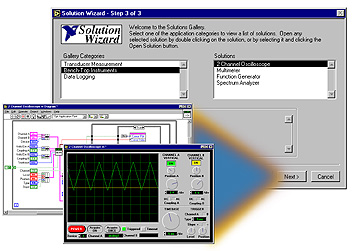Some windows from an application builder, the data acquisition and analysis software package LabView (National Instruments).

An application builder offers a series of modules linked by
interfaces which are connected interactively at runtime. It
combines features from other software categories by providing
turnkey solutions for individual parts of the program and the
flexibility to customise the final solution adopted. The supplied
modules can be replaced by user-written modules as required,
providing they conform to the data input/output interface
requirements, therefore giving greater extensibility.
In these systems virtually everything the user needs is provided by the program. The user has only to direct the execution path of the program, provide the data, and if required, their own computational modules.
Applications are constructed by mouse-driven interfaces,
manipulating icons on screens and linking them with data paths.
Once the required modules have been connected and built, the
program can be executed. New applications can be prototyped very
quickly by connecting modules in different ways but the user
needs to know how to manage the flow of data through the network,
and how to extend the module set. New advances in visualization
techniques and software will extend and improve the application
builder functionality. At present, only a few of these products
are advanced enough to have had a substantial number of packages
built around them.
Some windows from an application builder, the data acquisition
and analysis software package LabView (National Instruments).
